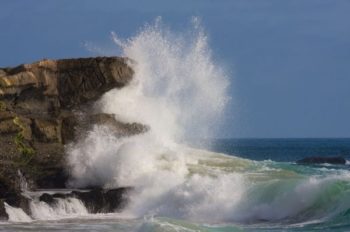An expert committee convened by the World Meteorological Organization (WMO) has established a new world record significant wave height of a massive 19 meters (62.3 feet!) measured by a buoy in the North Atlantic.
The wave was recorded February 4, 2013 by an automated buoy in the North Atlantic ocean between Iceland and the United Kingdom at approximately 59° N, 11° W.
The agency said the wave followed the passage of a very strong cold front, which produced winds of up to 43.8 knots (50.4 miles per hour) over the area.
The WMO Commission for Climatology’s Extremes Evaluation Committee, with scientists from Great Britain, Canada, the United States of America and Spain, classified the new record as “the highest significant wave height as measured by a buoy”.
“This is the first time we have ever measured a wave of 19 meters. It is a remarkable record,” said WMO Assistant Secretary-General Wenjian Zhang. “It highlights the importance of meteorological and ocean observations and forecasts to ensure the safety of the global maritime industry and to protect the lives of crew and passengers on busy shipping lanes.”
The WMO says the previous record wave height of 18.275 meters (59.96 feet) was measured on 8 December 2007, also in the North Atlantic.
The buoy, which recorded the wave, is a part of the UK Met Office’s network of Marine Automatic Weather Stations, used to complement ship-based measurements and satellite observations which monitor the oceans and forecast meteorological hazards on the high seas.
“We need high quality and extensive ocean records to help in our understanding of weather/ocean interactions,” said Zhang. “Despite the huge strides in satellite technology, the sustained observations and data records from moored and drifting buoys and ships still play a major role in this respect.”
A separate record – that of the highest significant wave height as measured by ship observation – was measured in February 2000 in the Rockall Trough, also in the North Atlantic between the UK and Iceland.
“The new world record will be added to the official WMO archive of weather and climate extremes which is being constantly updated and expanded thanks to continued improvements in instrumentation, technology and analysis,” said Randall Cerveny, Joint Rapporteur on World Records of Climate and Weather Extremes for WMO.
The archive includes the world’s highest and lowest temperatures, rainfall, heaviest hailstone, longest dry period, maximum gust of wind, as well as hemispheric weather and climate extremes.
Copyright Ships & Ports Ltd. Permission to use quotations from this article is granted subject to appropriate credit given to www.shipsandports.com.ng as the source.

